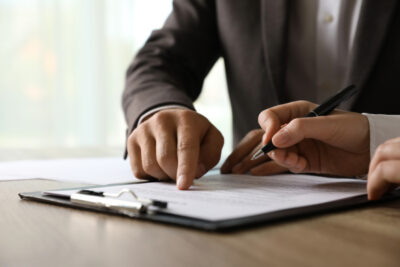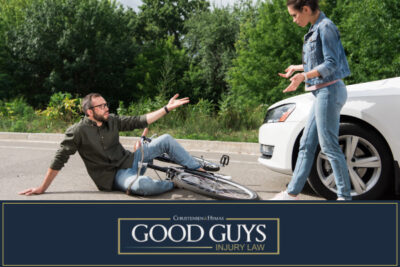
At Good Guys Injury Law, we understand a motorcycle accident can be an overwhelming experience. We aim to support you in these challenging times by providing clear and practical advice. Documenting evidence is necessary to protect your rights and ensure you receive fair compensation.
A personal injury attorney always emphasizes the importance of thorough documentation to our clients. Contact a Good Guys Injury Law attorney if you need help saving or storing evidence. We will share our best practices to preserve evidence and provide valuable insights to reach a fair settlement.
Table of Contents
The Importance of Documenting Evidence
Documenting evidence after a bicycle accident is essential for many reasons. First, it helps establish the facts of the incident, making it easier to prove liability. Second, it provides a clear picture of the extent of your injuries and damages. Without proper evidence, insurance companies might undervalue or deny your claim.
Furthermore, having well-documented evidence can speed up the settlement process. It ensures all parties involved have an unbiased view of what happened. This clarity can lead to more straightforward negotiations and a quicker resolution.
When it comes to collecting evidence, you have the right to:
- Photograph the scene: You can photograph the accident, including damages and injuries. Ensure you’re not trespassing on private property.
- Collect witness statements: You can ask witnesses for their statements. They have the right to decline, but gathering their input can be very helpful.
- Public records: You can obtain public records related to the accident, such as police reports and medical records. These records can provide official documentation of the incident.
Common Mistakes to Avoid When Collecting Evidence

After the bike crash, go to a safe location, but do not leave the scene. If it’s dark, use your phone’s flashlight or any available lights to alert oncoming traffic.
The following are some common mistakes that can be made when gathering evidence at a crime scene:
- Failing to take immediate photos: Photograph the scene as soon as possible. Waiting too long can result in changes to the scene, like vehicles being moved or debris being cleared, weakening your physical evidence.
- Not gathering witness information: Witnesses can provide essential details about the accident. Not collecting their contact information means losing valuable testimonies that could support your case.
- Ignoring minor injuries: Sometimes, people focus only on major injuries. Document minor injuries as they can develop into more serious conditions.
- Not calling emergency services: Call 911 immediately after ensuring your safety. Once you report the accident to the police, you create an official record, a key element of your case. Contact medical services even if you feel fine, as some injuries may not be immediately apparent. Notify your insurance company about the accident as soon as possible.
Gathering Evidence
Any accident scene evidence will help you sustain an injury claim against the parties involved. Make sure you get at least the following:
- Collecting vehicle information: Note the vehicles’ make, model, and license plate. This information helps identify the responsible parties accurately.
- Preserving damaged gear: Keep any damaged clothing or biking gear. These items can serve as physical proof of the effects and extent of the accident.
- Noting weather conditions: Write down the weather conditions during the accident. Wet roads or poor visibility can be vital factors in determining fault.
- Photographing the scene: Take clear photos of the accident scene from multiple angles. Include close-ups of any damage and wide shots to show the overall context. Make sure to capture traffic signs, signals, and road markings. Use a high-resolution camera if possible, but smartphone photos are also effective.
Capturing Vehicle Damage and Road Conditions

Photograph all visible damage to the vehicles involved, including your bike. Take pictures of skid marks (tire prints on the weather or road conditions), road debris, and any obstructions. These details can help reconstruct the accident later. Remember to take pictures of the surrounding area to provide context.
Video footage can be strong evidence of actual injuries sustained road conditions. Videos are visual evidence that can help accurately represent the events that day. Camera footage will benefit those seeking compensation and help present a solid case.
Collecting Personal and Other Additional Information
It is essential to gather personal information from everyone involved in bicycle accident in the first accident report. This includes names, phone numbers, addresses, and insurance details from the at-fault party.
This information will be essential in determining liability, for your case and any potential claims you need to make:
- Injuries: If you have any injuries, take photos of them, no matter how minor they may look. These can show the severity and location of your injuries over time.
- Property damage: Document any damage to personal belongings, like your bike, helmet, or clothing. These items can support your compensation claims.
- Witnesses and license plates: Photograph the license plates of the involved vehicles and any witnesses at the scene. This ensures you have their details if they leave before you can write them down.
Exchanging Information with Other Parties
Politely ask for all parties’ names, addresses, phone numbers, and insurance details. Ensure you get the driver’s license numbers and vehicle registration details. This information is vital for your accident attorney to begin filing insurance claims. Always remain calm and composed during this exchange and get all the evidence possible.
What Information to Gather from Witnesses
Ask witnesses for their full names, contact numbers, and addresses. Our best advice is to wait for us to contact these witnesses. We can begin establishing liability with the involved parties’ accounts.
Documenting Law Enforcement and Emergency Responders’ Details
Get the names and badge numbers of the responding officers in the immediate aftermath of the incident. Ask for a copy of medical report, the police report or the report number. This official document will be critical for your case. Record the names and details of any medical personnel who assist you.
Medical experts document your injuries in official medical records, validating their severity and repercussions. These records can considerably strengthen your case. Having your medical bills and expert testimony will benefit your settlement negotiations and in court.
Recording Your Account
After you’ve received immediate medical attention and treatment, get your facts together.
- Write down your account of the accident as soon as possible, with as much evidence as you can mention.
- Details like time, place, and events leading up to the incident should be included.
- Describe your immediate reactions and any pain or emotional distress you may feel since the bicycle accident.
This personal record can be very persuasive in your case and will help to prove fault and establish liability.
Creating a Timeline of Events
Try to replay and remember the way it started, during, and after the first accident occurred. Include exact times if possible. This timeline helps create a clear narrative of what happened and helps identify any discrepancies in other accounts.
Keeping Detailed Medical Records and Reports
Keep all medical reports, bills, and prescriptions related to your injuries. Document every visit to healthcare providers and the treatments you receive. These records are comprehensive evidence of your claims for medical expenses. They also highlight the aftermath of financial impact of the accident on your health.
Utilizing Technology for Evidence
Technology can be a powerful tool in documenting and preserving physical evidence. Use your smartphone to take photos, videos, and voice recordings. The police department will find this helpful, as beneficial as tangible proof.
Apps like iCloud, Google Drive, Dropbox, and Microsoft OneDrive can help organize and store this information securely and privately. If shared with your personal injury attorney, these apps can help with evidence collection and the whole insurance claims process.
Smartphones and Apps for Documentation
Smartphones are a great way to take and save evidence. Use it to take high-quality photos and videos of the accident scene, or any related evidence that can help with your compensation claim.
Dashcams and GoPros
Dashcams, GoPros, or body-worn cameras can provide continuous, real-time footage of the accident site. This video evidence can be critical in demonstrating what happened, and having this kind of footage makes it hard for anyone to dispute your account when pursuing compensation.
Creating a Secure Backup System
Ensure all your evidence is securely backed up. Use cloud storage to keep digital copies safe. Regularly update and organize your files. This protects any evidence related to the accident from being lost or damaged.
Legal Considerations and Privacy
When collecting evidence, respect privacy and legal boundaries. Always ask for permission before recording conversations, and avoid sharing sensitive information publicly.
With a free consultation, we can lay out any privacy considerations for your personal injury case, so you stay on the right track.
Preparing for Legal Proceedings
Organize your evidence and keep anything related to the accident scene. For example, keep everything clearly labeled and easily accessible.
This preparation can make the legal process smoother and more efficient. Personal injury attorneys will ensure that you have accurate representation and a well-organized evidence file.
How Proper Evidence Documentation Affects Litigation
You will easily build a strong case if you have detailed evidence supporting your claims. This can also prevent the opposing party from disputing your version of events. Good documentation of physical injuries can lead to a more favorable outcome in court for motorcycle accidents.
Let Our Utah Bike Accident Lawyer Help You Preserve Your Evidence

Having an experienced attorney is imperative when presenting your evidence in court. At Good Guys Injury Law, we specialize in handling bicycle accident cases and know how to present evidence efficiently to support your claim. We’ll guide you through every step, ensuring your evidence is compelling and organized.
With our expertise, you can confidently navigate the legal process and focus on your recovery. If you’ve been involved in a bike accident, contact Good Guys Injury Law for a free consultation. Let us help you gather and present the evidence you need for a successful outcome.
